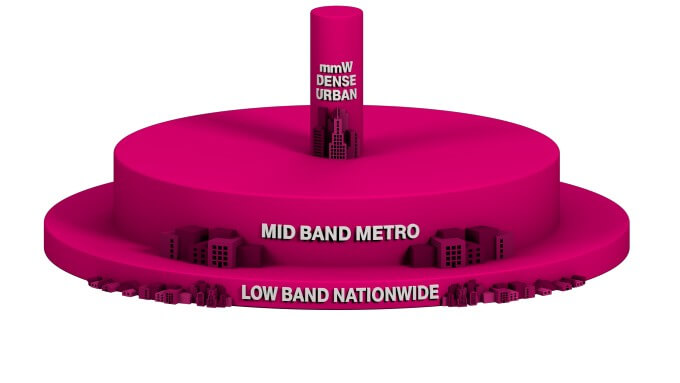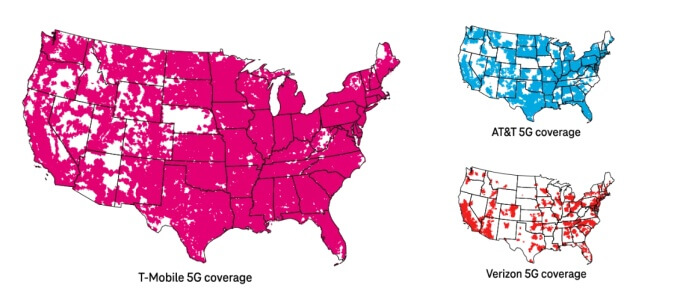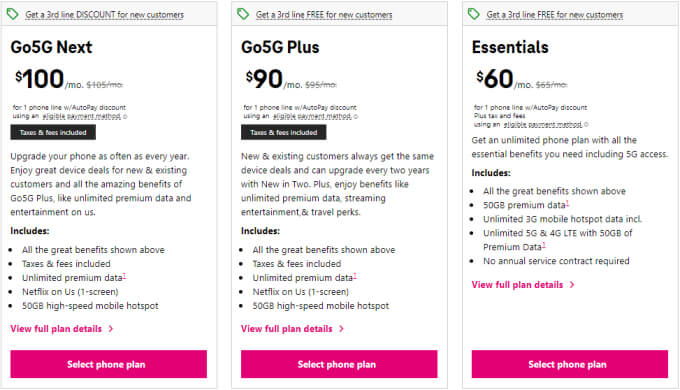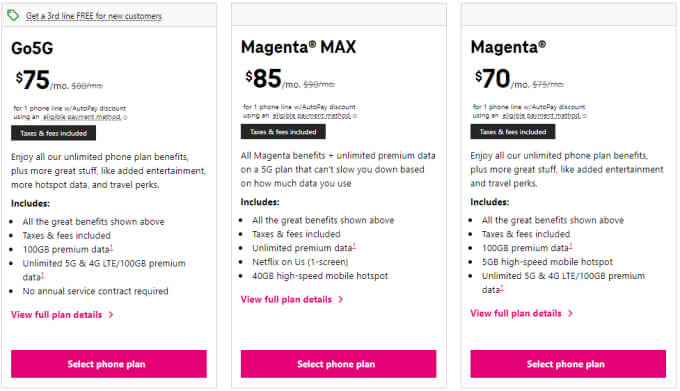What To Know About T-Mobile’s 5G Network & Coverage
T-Mobile 5G: Everything You Need to Know
T-Mobile is leading the 5G race. They offer the largest 5G coverage and fastest 5G speeds. Their goal is to build the most transformative 5G network that’ll offer reliable connectivity for all people and things. Let’s take a closer look at their 5G offerings.
We fix poor cell phone signal! Find the right signal booster for you:




In this blog:
- T-Mobile's 5G Spectrum
- What 5G Frequencies Does T-Mobile Use?
- How Fast is T-Mobile 5G?
- How is T-Mobile's 5G Network Different from AT&T and Verizon?
- What is T-Mobile 5G Extended Range and 5G Ultra Capacity?
- Where is T-Mobile 5G Available?
- Do T-Mobile Plans Include 5G?
- How Does T-Mobile 5G Home Internet Work?
- Do Signal Boosters Work with T-Mobile 5G?
- Other FAQs
T-Mobile's 5G Spectrum
5G is the fifth generation of wireless mobile networks. It’s meant to deliver faster speeds, lower latency, and greater capacity than previous generations. It does this by operating across three different frequency layers: low-band (<1GHz), mid-band (between 1 GHz and 6 GHz), and high-band (>53 GHz).
Each layer offers different speeds, coverage, and capacity. To deliver #5GForALL, T-Mobile took a “layer cake approach” to 5G.

T-Mobile began building out the foundation of the cake using the 600 MHz low-band spectrum to provide nationwide 5G coverage. During that time AT&T was focused on marketing 4G as 5G and Verizon on the mmWave of 5G.
Low-Band 5G signals can travel long distances and penetrate obstacles pretty well. Though, they don’t offer super-fast speeds. T-Mobile claims its low-band speeds can range from 30-75 Mbps. The 600 MHz Low-Band 5G network launched on Dec 2, 2019, covering more than 200 million people and over 5,000 cities and towns.
In April 2020, the middle layer of the cake was added. It’s comprised of the 2.5 GHz band and C-Band (3.45 GHz and 3.7 GHz). This layer is very important for 5G, as it’s the Goldilocks band. It offers much faster speeds than low-band and more coverage range than high-band. Speed may range between 115-223 Mbps.
The cake topper is high-band, also called mmWave (millimeter wave). T-Mobile's high-band is made up of 24 GHz, 28 GHz, and 39 GHz spectrum. They’ve also bought spectrum in the 37 GHz and 47 GHz bands. These signals have insane capacity and speed that can range from 450 Mbps to 1+ Gbps. However, mmWave signals can't travel far nor penetrate obstacles. Main use cases will be in densely populated urban areas and busy venues.
What 5G Frequencies Does T-Mobile Use?
Each carrier uses different sets of 5G frequencies. T-Mobile uses:
| Low-Band 5G Frequencies | Mid-Band 5G Frequencies | High-Band 5G Frequencies |
| 600 MHz: Band n71 | 1.9 GHz: Band n25 2.5 GHz: Band n41 3.45 GHz: Band n2 (Pending Deployment) 3.7 GHz: Band n77 (Pending Deployment) |
24 GHz: Band n258 28 GHz: Band n261 37 GHz (Pending Deployment) 39 GHz: Band n260 47 GHz: Band n262 (Pending Deployment) |
How Fast is T-Mobile 5G?
In its perfect form, 5G is capable of delivering speeds up to 20 Gbps. That's about 200 times faster than 4G. However, 5g speeds aren't quite there yet. T-Mobile 5G speeds average:
- 30 to 75 Mbps on T-Mobile's Low-Band 5G
- 115 to 223 Mbps on T-Mobile's Mid-Band 5G
- 450+ Mbps on T-Mobile's High-Band 5G
When compared to the competition, T-Mobile offers the fastest 5G speeds available. The latest OpenSignal 5G Report reveals that T-Mobile 5G is twice as fast as Verizon and 2.4 times faster than AT&T.

To deliver greater speed and performance, T-Mobile 5G announced the use of carrier aggregation in 2023. This technology combines multiple 5G channels (or carriers) to create a faster highway for data to travel through. Users with the Samsung Galaxy S23 will be the first to experience carrier aggregation with more devices to follow.
How is T-Mobile's 5G Network Different from AT&T and Verizon?
Unlink Verizon 5G and AT&T 5G, T-Mobile's 5G network is mainly built on dedicated – not shared – spectrum.
AT&T and Verizon both use a technology called Dynamic Spectrum Sharing (DSS). It allows their low-band and some mid-band 5G frequencies to coexist amongst 4G frequencies. This means 5G and 4G share bandwidth, which impacts capacity and speed. T-Mobile describes it as “forcing more traffic into the same number of lanes”.
Few T-Mobile 5G bands operate the same way. When building out their 5G network they focused on adding exclusive lanes for 5G traffic. This allows their network to support more devices at the same time and deliver faster speeds.
What is T-Mobile 5G Extended Range and 5G Ultra Capacity?
With there being different “layers” of 5G, all carriers use different names when referring to their 5G networks.
T-Mobile markets its new generation network as Extended Range (XR) 5G and Ultra Capacity (UC) 5G.
Extended Range 5G refers to T-Mobile's Low-Band 5G network (not to be confused with Extended Range LTE). Ultra Capacity 5G refers to T-Mobiles' faster mid- and high-band networks.
The icon on your 5G-compatible device will change depending on which network you’re connected to. A standard 5G icon indicates you’re connected to Extended Range 5G. AT&T and Verizon use the same icon for their Low-Band 5G networks. When connected to Ultra Capacity 5G, the icon will change to 5G UC. AT&T uses “5G+” and Verizon uses “5G UW or 5G UWB” for their Mid- and High-Band 5G networks.
Where is T-Mobile 5G Available?
T-Mobile has the largest 5G coverage area. They offer more 5G coverage than Verizon and AT&T.

Their initial 5G launch covered over 200 million people across 1 million square miles. Their coverage has only continued to expand.
As of Oct 2023, T-Mobile's footprint reached over 330 million people nationwide. Though, it’s still not available everywhere.
To see if T-Mobile's 5G reaches your neck of the woods, look up your address on the T-Mobile 5G coverage map. If you're an existing or future T-Mobile Prepaid customer, check out their prepaid 5G coverage map.
You will not be able to find cell tower location information through these maps. If that's something you're interested in, check out our blog covering T-Mobile cell towers near you for instructions.
Do T-Mobile Plans Include 5G?
To access T-Mobile's 5G network, you need a 5G-compatible device and plan.
T-Mobile has a ton of 5G devices from Samsung, Apple, Google, OnePlus, LG, Motorola, and more. You can view all their 5G devices here. Pair it with a 5G plan, and you'll be able to enjoy better signal and faster speeds anywhere 5G is available.
All T-Mobile plans include Extended Range 5G and Ultra Capacity 5G access at no extra cost. Some carriers, like Verizon, allow access to all three 5G layers on some plans and only low-band access on others. It’s always important to read the fine print.
Here is a snapshot of T-Mobile's unlimited talk, text, and data 5G plans:


Even their more affordable Connect by T-Mobile and Simply Prepaid plans include XR 5G and UC 5G. The main differences between the two prepaid services are cost and data options.
How Does T-Mobile 5G Home Internet Work?
T-Mobile also offers 5G Home Internet, available to more than 30 million households nationwide. After signing up, you’ll receive a 5G Gateway (router and modem combo device) in the mail. Installation is quick and easy. Within 15 minutes all devices in your home or office will receive reliable WiFi 6 connectivity.
The Gateway picks up 5G signals and converts them into fast, reliable WiFi. If 5G isn't available in your area, it also works with 4G and LTE signals. Speed will vary depending on your signal environment. Subscribers typically see download speeds between 33-182 Mbps and upload speeds between 6-23 Mbps.
Service is only $50 a month with autopay. There are no hidden fees, no price hikes, no annual contracts, and no data caps. It’s a great option for those in areas where traditional internet is unavailable or too expensive.
Do Signal Boosters Work with T-Mobile 5G?
While you may live in a 5G area, sometimes cell tower distance and building materials prevent you from enjoying reliable 5G indoors. The best solution for situations like these are cell phone signal boosters. They’re designed to capture existing cell signals operating on certain frequencies, boosting them, and relaying them inside.
Most signal boosters support 4G and 5G frequencies 700 MHz, 850 MHz, 1.7/1.2 GHz, and 1.9 GHz.
If you compare the supported frequencies to T-Mobile's 5G frequencies, you’ll notice that the only one that matches is the 1.9 GHz band. This is because T-Mobile's 5G network is mainly built on dedicated spectrum that doesn’t share bandwidth with 4G. Thus, most signal boosters do not currently work with T-Mobile's full 5G networks. You can read more about it here.
The only amplifier that works with T-Mobile is the WilsonPro 710i. It’s exclusively designed to boost T-Mobile's Band 71 (600 MHz). It’s going to take a few years for a true 5G signal booster to hit the market.

All signal boosters, however, continue to work with T-Mobile's 4G network. If you’re constantly experiencing dropped calls and slow data, enhancing 4G signals inside your home, office, or vehicle will help.
One of the 710i’s biggest selling points is pairing it with T-Mobile Home Internet.
Wilson Amplifiers is the leading provider of signal boosters. You can enjoy reliable talk, text, and data anywhere you need – at home, in the office, or on the go. If you have any questions, call (1-800-568-2723), email (sales@wilsonamplifiers.com), or chat with us. We’re happy to help!
Other FAQs
What is the Difference Between 5G and 4G?
In a nutshell, 5G offers faster speeds, more capacity, better reliability, and less latency than 4G. For more information, visit our blog on 4G vs 5G vs LTE.
How Do I Know if T-Mobile 5G is Available in my Area?
There are two ways to tell if you're in a 5G area:
- If you have a 5G device, a 5G or 5G UC icon will appear on your phone’s status bar.
- Look up your address on T-Mobile's 5G Coverage Map.
Will My Phone Work With T-Mobile 5G?
As long as your device is 5G capable, then yes. However, you'll want to check the frequencies your mobile device supports as it may not work with the full network.
What is Extended Range 5G?
T-Mobile calls its Low-Band 5G network Extended Range 5G. These signals can travel long distances and penetrate obstacles well. Speed is only slightly faster than 4G.
What is Ultra Capacity 5G?
T-Mobile calls its Mid- and High-Band 5G networks Ultra Capacity 5G. These signals offer faster speeds and more capacity than Extended Range 5G. However, they have a shorter coverage range.
What Does the 5G UC Icon Mean?
The 5G UC icon on your phone’s status bar means you’re connected to T-Mobile's Ultra Capacity 5G network.
What’s the Difference Between T-Mobiles 5G and 5G UC Icons?
The 5G and 5G UC icons represent which 5G network you’re connected to. The standard 5G icon shows you’re connected to Extended Range 5G, while 5G UC shows you’re connected to Ultra Capacity 5G.
Does T-Mobile Charge Extra for 5G?
No. All T-Mobile plans include Extended Range 5G and Ultra Capacity 5G access at no extra cost.
Interested in Learning More? Check Out Our Signal Boosting Info Center


Money Back Guarantee

Technical Support